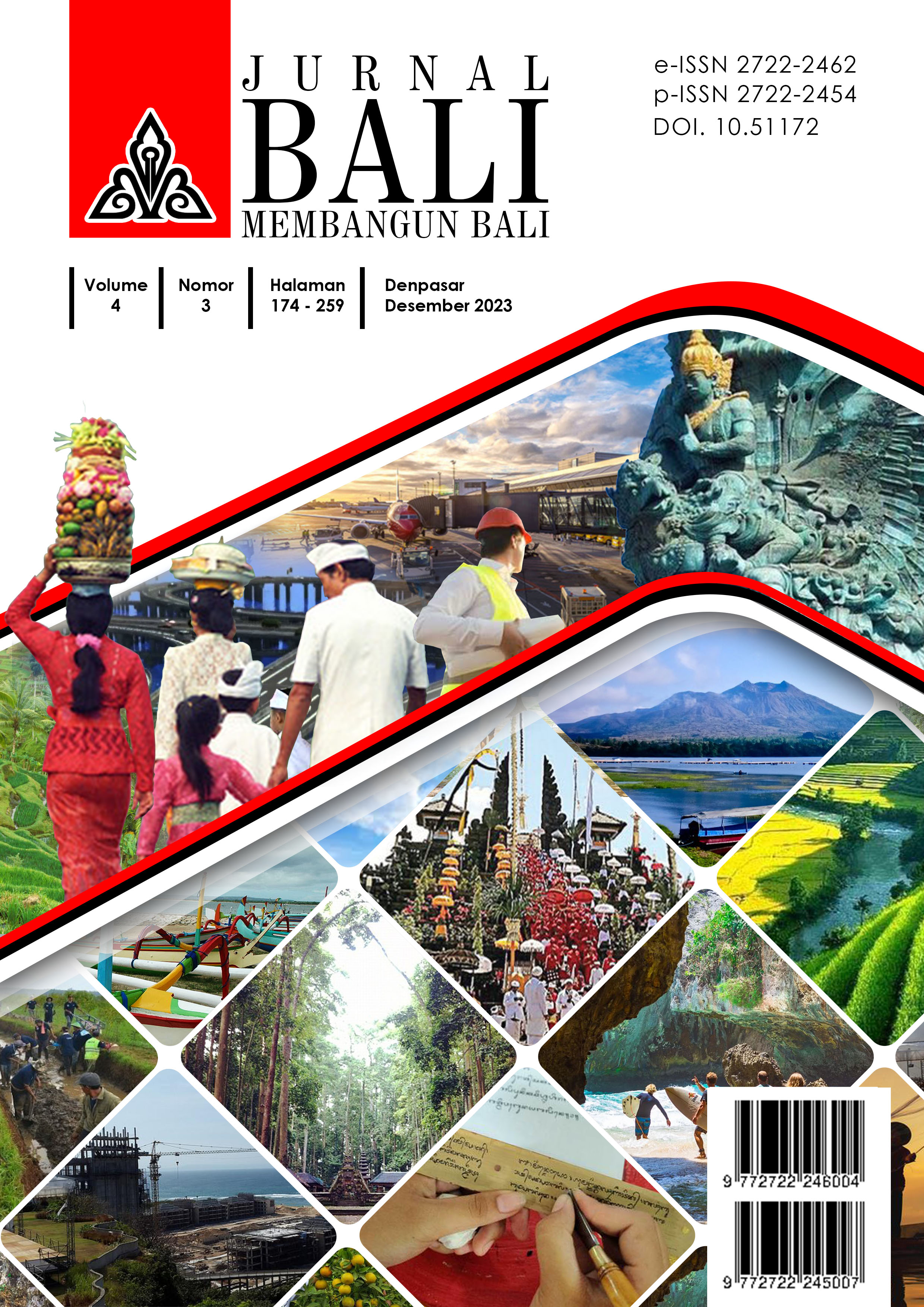Main Article Content
Abstract
Purpose: Sesandaran Baris Dance was created as a medium for developing character education.
Research method: The creation method involves three stages, namely exploration, improvisation and forming which are still based on the basic elements of Balinese dance such as agem, tandang, tangkis, dan tangkep. The structure of the work consists of pepeson, pengawit, pengawak, pengecet, and pekaad. Furthermore, the study is descriptive qualitative in order to explain that the Baris Sesandaran dance is able to show as a medium for developing character education.
Results and discussion: Baris Sesandaran Dance, a new creation inspired by the art of Barong Landung from Banjar Kaliungu Kelod Denpasar which has been stored for 17 years. This dance has a religious theme, puts more emphasis on the expression of will, performed by 8 male dancers carrying incense props, dancing while interspersed with singing songs together and shouting at each other as an identity in the Barong Landung art. This reciprocal song is called Sesandaran. Implications: The Baris Sesandaran dance is able to show as a vehicle for developing character education and as the development of the Barong Landung art in the form of a creational dance so that it can be passed on to the next generation.abstracts in English.
Keywords
Article Details

This work is licensed under a Creative Commons Attribution-NonCommercial-ShareAlike 4.0 International License.
Authors who publish with this journal agree to the following terms:
Authors retain copyright and grant the journal right of first publication with the work simultaneously licensed under a Attribution-NonCommercial-ShareAlike 4.0 International (CC BY-NC-SA 4.0) that allows others to share the work with an acknowledgement of the work's authorship and initial publication in this journal.
Authors are able to enter into separate, additional contractual arrangements for the non-exclusive distribution of the journal's published version of the work (e.g., post it to an institutional repository or publish it in a book), with an acknowledgement of its initial publication in this journal.
Authors are permitted and encouraged to post their work online (e.g., in institutional repositories or on their website) prior to and during the submission process, as it can lead to productive exchanges, as well as earlier and greater citation of published work (See The Effect of Open Access).
References
- Channel Gaduh Sesetan. (2006). Lawas, Barong Landung, Ida Ratu Made Kahyangan Sakti Br. Tainsiat, Denpasar 2006, https://www.youtube.com/watch?v=eIS4Clp1fic&t=495s, uploaded 3 September 2020.
- Hawkins, A. M. (1990). Mencipta lewat Tari (Creating through Dance), translated by Sumandyo Hadi. Yogyakarta: Institut Seni Indonesia Yogyakarta.
- Bandem, I M. (1983). Ensiklopedia Tari Bali. Denpasar: Akademi Seni Tari Indonesia (ASTI) Denpasar.
- Bandem, I M. (1996). Etnologi Tari Bali. Yogyakarta: Penerbit Kanisius.
- Bandem, I M & Boer. F. E. de (2004). Kaja dan Kelod Tarian Bali and Kelod Balinese Dance in Transition. Under the license of Oxford University Press. Yogyakarta: Institut Seni Indonesia Yogyakarta.
- Dibia, I W. (2003). Bergerak menurut Kata Hati: Metode Baru dalam Menciptakan Tari (Terjemahan dari Moving from within: A New Method for Dance Making by Alma M. Hawkin). Jakarta: Ford Foundation dan Masyarakat Seni Pertunjukan Indonesia (MSPI).
- Hadi, Y. S. (1990). Mencipta Lewat Tari (Translation of Creating through Dance by Alma M. Hawkins). Yogyakarta: Institut Seni Indonesia Yogyakarta.
- Hadi, Y. S. (2007). Kajian Tari Teks dan Konteks. Yogyakarta: Pustaka Yogyakarta: Book Publisher, Yogyakarta.
- Kesuma, D., Triatna, C., & Johar Permana, P. K. (2012). Kajian Teori dan Praktik di Sekolah, Bandung: PT. Remaja Rosdakarya.
- Koesoema, D. (2007). Pendidikan Karakter: Strategi Mendidik Anak Zaman Global. Jakarta: Grasindo.
- Purwaningtyas, G. (2018). Nilai Pendidikan Karakter Dalam Ragam Gerak Tari Srimpi Pandelori. Mudra Jurnal Seni Budaya, 33(2), 182-190.
- Swadiana, J. M. O. (2008). Barong Landung, Bernuansa, Magis-Religius. Surabaya: Paramita, Surabaya.
- Setiawan, H., Rakhmawati, A., & Anindyarini, A. (2020). Pertunjukkan Ketoprak Lakon Pedhut Jatisrana Sebagai Media Pendidikan Karakter. Mudra Jurnal Seni Budaya, 35(3), 331-336.
- Sumaryono. (2007). Jejak dan Problematika, Seni Pertunjukan Kita. Yogyakarta: Prasista, Yogyakarta.
- Sustiawati, N. L., Suryatini, N. K., & Artati, A. A. A. M. (2018). Pengembangan Desain Pembelajaran Seni Tari Di Sekolah Dasar Berbasis Local Genius Knowledge Berpendekatan Integrated Learning. Mudra Jurnal Seni Budaya, 33(1), 128-143.
- Sustiawati, N. L., Negara, I. G. O. S., Sumarno, R., & Nalan, A. S. (2020). Merangkai Nusantara Melalui Seni Wadantara. Mudra Jurnal Seni Budaya, 35(2), 182-195.
- Syarbini, A. (2012). Buku pintar pendidikan karakter. Jakarta: Prima Pustaka.
- Tim Penyusun. (2008). Kamus Besar Bahasa Indonesia. Balai Pustaka: Jakarta

